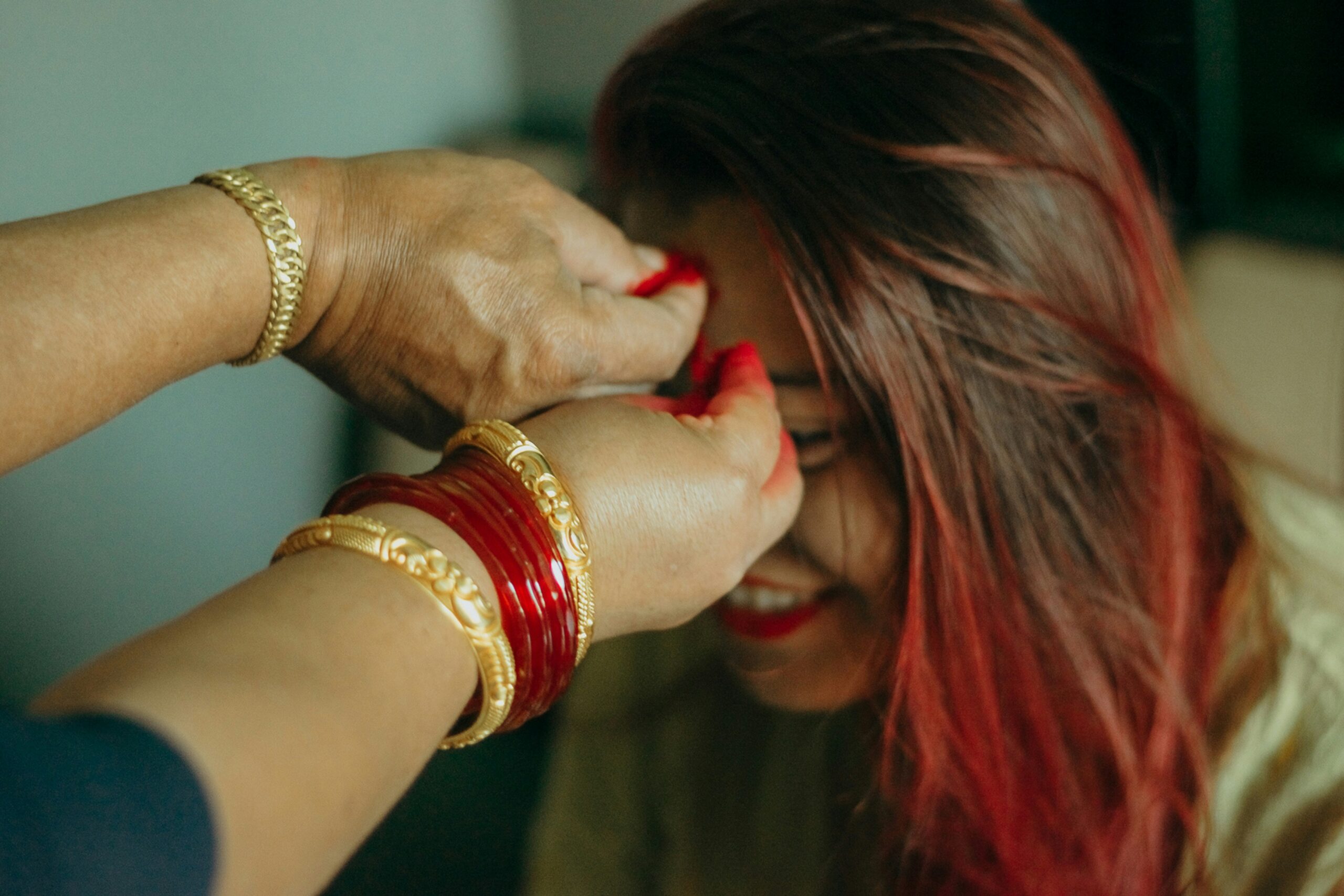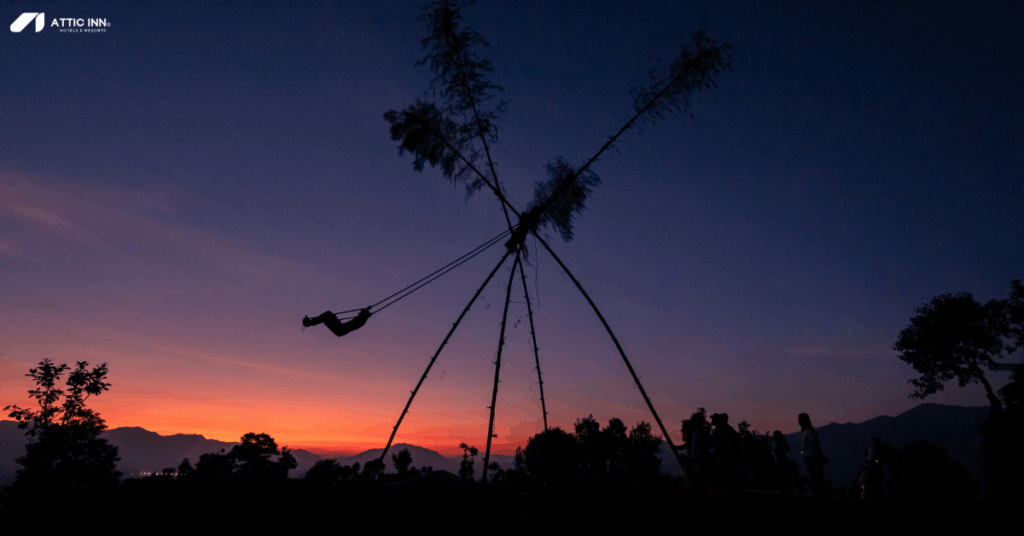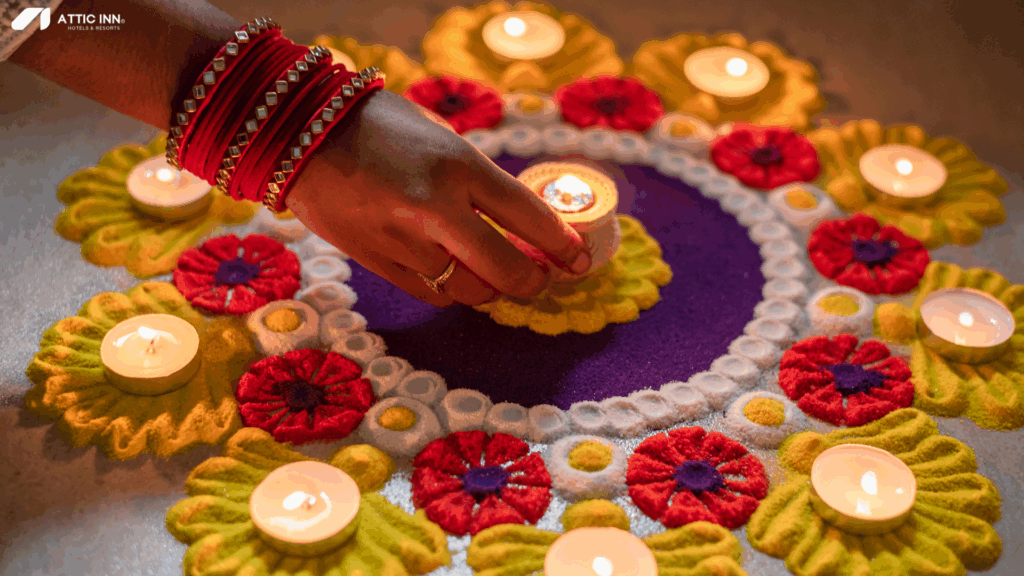
Nepal is a land of rich traditions and deep spirituality, where festivals are more than just celebrations—they are a way of life. Dashain and Tihar, the two biggest Hindu festivals in Nepal, bring families, communities, and the entire nation together in devotion, joy, and cultural pride. These vibrant festivals showcase Nepal’s heritage, mythology, and social harmony, while offering travelers a unique opportunity to experience the country at its most festive and colorful.
Dashain Festival in Nepal – The Victory of Good Over Evil.
Dashain, also known as Bijaya Dashami or Bada Dashain, is the longest and grandest Hindu festival in Nepal. Celebrated for 15 days during Ashwin (September–October), it commemorates the victory of goddess Durga over the demon Mahishasura, symbolizing the eternal triumph of good over evil.
Major Days of Dashain
- Day 1 – Ghatasthapana: Sowing jamara (barley seeds) in a Kalash, symbolizing prosperity. Daily puja continues until Day 7.
- Day 7 – Phulpati: Sacred offerings are brought from Gorkha to Kathmandu; families honor goddess Durga.
- Day 8 – Maha Ashtami: Devotees worship Durga and Kali; temples and families perform rituals and feasts.
- Day 9 – Maha Navami: Tools, vehicles, and equipment are worshiped as a sign of respect for livelihood.
- Day 10 – Bijaya Dashami (Bada Dashain): Elders bless younger relatives with tika and jamara; families celebrate with reunions, feasts, and gifts.
- Day 11 – Papakunsha Ekadashi: Auspicious day for fasting; some families continue tika visits.
- Day 15 – Kojagrat Purnima: Worship of goddess Laxmi for prosperity and well-being.
Cultural Highlights of Dashain
- Family reunions and homecomings.
- Buying and wearing new clothes.
- Playing on bamboo swings, flying kites, and playing card games.
- Music, dance, and feasting on traditional dishes like goat meat curry.

Travel Between Dashain and Tihar – Perfect Time for Trekking
The gap between Dashain and Tihar (2–3 weeks) offers excellent weather for trekking and travel. The skies are clear, and the air is dry, providing perfect mountain views. Some popular options include:
- Ghorepani Poon Hill Trek: Famous for sunrise views over Annapurna and Dhaulagiri. Explore Poon Hill Trek in detail here for the full itinerary, tips, and travel guide.
- Mardi Himal Trek: A short but stunning trek to the foothills of Machhapuchhre (Fishtail Mountain). Learn more about the trek here.
- Cultural Tours of Pokhara and Kathmandu: Explore lakes, caves, temples, and heritage sites while locals prepare for Tihar.
- Everest or Annapurna Region Treks: Ideal for longer trekking adventures.
Tihar Festival in Nepal – The Festival of Lights
Tihar, also known as Deepawali or Yama Panchak, is a five-day festival that follows Dashain. Unlike Dashain, Tihar focuses on honoring animals, nature, goddess Laxmi, and sibling relationships.
Major Days of Tihar
- Day 1 – Kaag Tihar: Worship of crows, considered messengers of Yama. Grains and food are offered.
- Day 2 – Kukur Tihar: Dogs are worshiped for loyalty and protection, adorned with garlands and tika.
- Day 3 – Gai Tihar & Laxmi Puja: Cows, representing goddess Laxmi, are worshiped; homes are decorated with diyos, candles, and rangoli. Children sing Deusi-Bhailo.
- Day 4 – Govardhan Puja & Mha Puja: Oxen and the Govardhan hill are worshiped. The Newar community performs Mha Puja (self-worship), marking the Nepal Sambat New Year.
- Day 5 – Bhai Tika: Sisters apply a special tika to their brothers, wishing them long life and prosperity; in return, brothers give gifts.
Cultural Highlights of Tihar
- Homes lit with oil lamps, candles, and colorful lights.
- Rangoli (mandalas) at entrances to welcome prosperity.
- Traditional music, dancing, and Deusi-Bhailo.
- Strengthening family and sibling bonds.

Exploring Nepal After the Festivals
After Dashain and Tihar, the country is perfect for:
- Trekking in the Himalayas: Annapurna, Everest, and Langtang trails.
- Cultural Tours: Temples, palaces, and heritage sites in Kathmandu, Bhaktapur, and Patan. Explore tours with Attic Inn.
- Relaxing in Pokhara: Lakeside walks, boating, and Himalayan panoramas.
- Exploring Unique Regions: Mustang, Upper Dolpo, Rara, and Khaptad for stunning landscapes and culture.
Visiting Nepal during this time allows travelers to experience both vibrant traditions and breathtaking natural beauty. Book your stay across Nepal with Attic Inn while touring.
Cultural Importance of Dashain and Tihar
Together, these festivals embody Nepal’s cultural essence:
- Dashain: Symbolizes victory, blessings, and family unity.
- Tihar: Celebrates light, gratitude, and respect for all living beings.
For travelers, Dashain and Tihar offer a once-in-a-lifetime opportunity to immerse in Nepali hospitality, savor traditional cuisine, and witness rituals that blend spirituality with community celebrations. More than just festivals, they are cultural journeys reflecting devotion, family bonds, gratitude, and joy. From receiving tika during Dashain to lighting diyos during Tihar, these celebrations capture the essence of Nepal’s unity and cultural richness, leaving visitors with unforgettable memories of the country’s most vibrant traditions.
FAQs on Dashain and Tihar in Nepal
1. How are Dashain and Tihar celebrated?
Dashain: Families reunite, prepare feasts, play traditional games, and receive blessings with tika (red vermilion) and jamara (barley shoots) from elders.
Tihar: Known as the Festival of Lights, it involves honoring animals like crows, dogs, cows, and oxen. Homes are decorated with lights and rangoli, and families perform Laxmi Puja.
2. Which god is worshipped in Dashain and why?
Goddess Durga is the main deity of Dashain, worshipped for her victory over the demon Mahishasura, symbolizing the triumph of good over evil.
3. What is the story behind Tihar?
Tihar is a five-day festival honoring Yama, the God of Death, and Laxmi, the Goddess of Wealth. Each day is dedicated to different beings—starting with crows (Kaag Tihar), considered Yama’s messengers, and ending with Bhai Tika, which celebrates sibling bonds.
4. What are the nine forms of Goddess Durga (Navadurga)?
- Shailaputri
- Brahmacharini
- Chandraghanta
- Kushmanda
- Skandamata
- Katyayani
- Kalaratri
- Mahagauri
- Siddhidatri
Each represents a different aspect of Durga and is worshipped during Navratri.
5. Why are animals worshipped in Tihar?
- Crows (Kaag Tihar): Messengers of Yama.
- Dogs (Kukur Tihar): Honored for loyalty and as Yama’s companions.
- Cows (Gai Tihar): Sacred in Hinduism, symbolizing prosperity.
- Oxen (Goru Tihar): Honored for their role in farming.
6. Is Tihar the same as Diwali?
Tihar is Nepal’s version of Diwali. Both celebrate lights and Goddess Laxmi, but Tihar uniquely includes animal worship and concludes with Bhai Tika.
7. What is the myth of Bhai Tika?
Legend says a sister once received a boon from Yama ensuring her brother’s life until the tika and garlands faded. Today, sisters apply tika to their brothers, praying for health and longevity.
8. What is the meaning of tika, and why is it red?
Tika (tilaka) on the forehead symbolizes blessings, protection, and spiritual insight. The red color, made from vermilion (sindoor or kumkum), represents love, power, purity, and devotion, often associated with Goddess Parvati.
9. Who celebrates Dashain and Tihar?
They are primarily celebrated by Hindus in Nepal and Nepali communities worldwide. Both festivals focus on family unity, devotion to deities, and the victory of good over evil.
10. How long do the festivals last?
- Dashain: 15 days, with Bijaya Dashami (Day 10) as the main celebration.
- Tihar: 5 days, with each day dedicated to different beings and deities.
11. Can tourists experience Dashain and Tihar?
Yes! Tourists are often welcomed to observe rituals, enjoy festive foods, and participate in family and community celebrations.
12. When are Dashain and Tihar celebrated?
They are celebrated between September and November (Ashwin–Kartik). Dashain comes first, followed a few weeks later by Tihar.
DEX analytics platform with real-time trading data – https://sites.google.com/walletcryptoextension.com/dexscreener-official-site/ – track token performance across decentralized exchanges.
Privacy-focused Bitcoin wallet with coin mixing – https://sites.google.com/walletcryptoextension.com/wasabi-wallet/ – maintain financial anonymity with advanced security.
Lightweight Bitcoin client with fast sync – https://sites.google.com/walletcryptoextension.com/electrum-wallet/ – secure storage with cold wallet support.
Full Bitcoin node implementation – https://sites.google.com/walletcryptoextension.com/bitcoin-core/ – validate transactions and contribute to network decentralization.
Mobile DEX tracking application – https://sites.google.com/walletcryptoextension.com/dexscreener-official-site-app/ – monitor DeFi markets on the go.
Official DEX screener app suite – https://sites.google.com/mywalletcryptous.com/dexscreener-apps-official/ – access comprehensive analytics tools.
Multi-chain DEX aggregator platform – https://sites.google.com/mywalletcryptous.com/dexscreener-official-site/ – find optimal trading routes.
Non-custodial Solana wallet – https://sites.google.com/mywalletcryptous.com/solflare-wallet/ – manage SOL and SPL tokens with staking.
Interchain wallet for Cosmos ecosystem – https://sites.google.com/mywalletcryptous.com/keplr-wallet-extension/ – explore IBC-enabled blockchains.
Browser extension for Solana – https://sites.google.com/solflare-wallet.com/solflare-wallet-extension – connect to Solana dApps seamlessly.
Popular Solana wallet with NFT support – https://sites.google.com/phantom-solana-wallet.com/phantom-wallet – your gateway to Solana DeFi.
EVM-compatible wallet extension – https://sites.google.com/walletcryptoextension.com/rabby-wallet-extension – simplify multi-chain DeFi interactions.
All-in-one Web3 wallet from OKX – https://sites.google.com/okx-wallet-extension.com/okx-wallet/ – unified CeFi and DeFi experience.

Leave a Reply